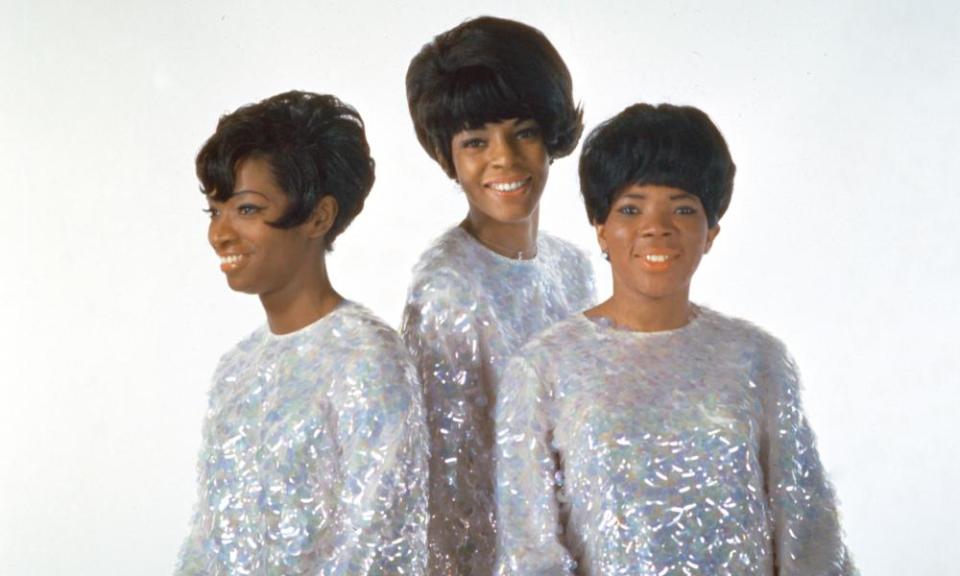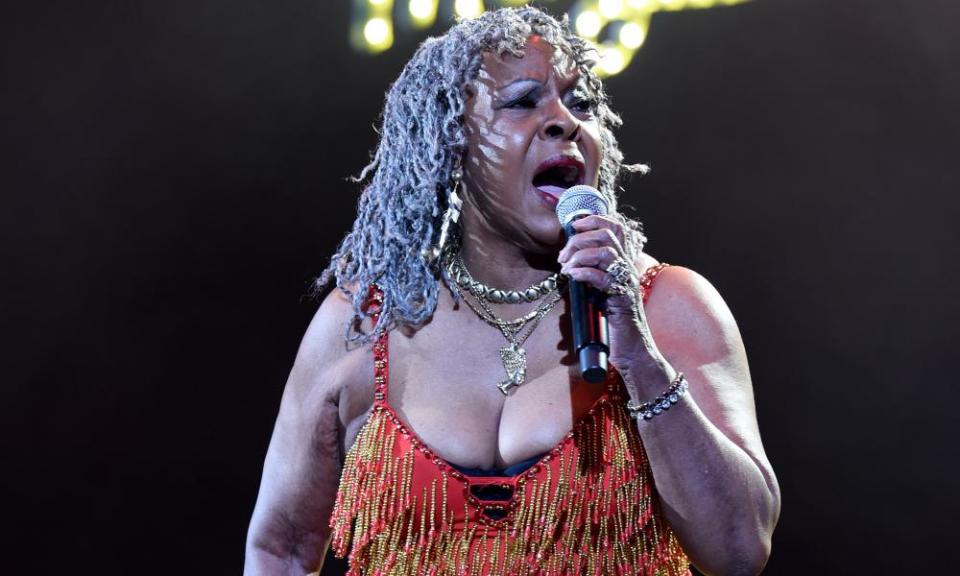'We had been beat down a lot': the story behind 60s protest anthem Dancing in the Street

A few weeks ago, the Motown singer Martha Reeves went to her first protest march since this historic wave began. “I saw people from everywhere, walking together in peace,” she told the Guardian. “They weren’t rioting, or beating, or fighting, but walking together in harmony.
“Some were even doing line dances!” she said. “They were actually dancing in the street. And it’s about time.”
Related: Mary Wilson of the Supremes: ‘Motown was like walking into Disneyland’
After all, Reeves has been singing, and talking, about Dancing in the Street, and its many, unfolding meanings, for over half a century now. Right after she recorded the exuberant anthem in July of 1964 as frontwoman of Martha and the Vandellas, it became a worldwide smash, selling millions of copies while serving as the song of its summer. At the same time, its lyrical “invitation across the nation … for folks to meet” in the street – matched to a melody and vocal as urgent as a clarion call – soon took on a second, more pointed, meaning. The transformation took place during the long, hot summers of 1964 and 65, “when riots broke out, in every city in the nation”, Reeves recalled. “Just like now, the police brutality and the government trying to control black people, prompted the uprising that was a revolution.”
Some of those who led that revolution – including the key Black Power figure H Rap Brown, and the Black Panthers – adopted Reeves’s song as their unofficial anthem, despite the fact that its lyrics had not a trace of the anger, or defiance, that fired their speeches. Still, the subtextural connection between the song and the ongoing politics of race didn’t surprise the song’s producer, William “Mickey” Stevenson, who also co-wrote it, with Marvin Gaye and Ivy Jo Hunter. “Our song was speaking to the times,” he said. “It was giving out a message to the parents that everyone should be with each other, peacefully, and it was giving out a message to those who have radical ideas. And it still seems relevant.”
Yet, when the song was first conceived its writers’ main goal was the same as any commercially minded music-maker – to get a hit. For Stevenson who, at the time, also headed the A&R department at Motown, the inspiration was a memory from his youth. “In Detroit, we used to take the caps off the fire hydrants and let the water spurt high,” he said. “The fire department would let you do that in some places. All these kids would be playing in the water, hugging each other, all over the street and I thought it was the most beautiful thing in the world. I kept that image in my head when we were writing.”
Huddled together in the attic of Stevenson’s house, the writers traded musical and lyrical ideas for hours, working around the clock to try to devise sounds joyous and rousing enough to capture the mood of people bonded in harmonious play. “We wanted to make a big statement, that everybody should come together in love,” he said.
Once the creators had the melody and lyrics down, they recorded a demo without a vocal, and with Gaye manning many of the instruments. At the time, they intended the song for singer Kim Weston, who sang key duets with Gaye and who was, then, living with Stevenson. Reeves, who started at Motown as Stevenson’s assistant, had always been eager to show her talents, volunteering to sing on many demos in her early days at the company. Along with the Vandellas, she also backed Gaye on some of his first hits. But by the summer of 64, she and her group had scored two top 10 hits of their own, (Love is Like a) Heat Wave and Quicksand. Even so, Reeves held Gaye in awe. “I’d follow him around, because he was so fine,” she said, with a laugh.
Both Gaye and Stevenson thought Reeves should create a demo vocal for Dancing to indicate for Weston how she should sing it. But once Reeves finished her vocal, Stevenson recalled, the writers all turned to each other and said: “‘Man, did you hear what I just heard?’ We knew it was a smash from the way Martha sang it. She gave it the feeling of joy. It put another light on the song.”
“I sang the song the way I felt it,” said Reeves. “I thought back to when I was a child. My dad worked for the city water department, and Mr Elliott, who lived on the corner, worked for the bus company. So, being city employees, they requested from the city council to let us block off the street every Saturday night so we could dance in the street. We had no dance hall. So, this was our reward for a hard week of work or school. On those nights, we felt so free.”
Stevenson’s choice of Reeves to sing the final recording instead of Weston, might not have pleased the latter singer, but, he says “as the A&R man, my job is the give the tune to the person that can deliver it best.”
In turn, Reeves didn’t just revel in the tune and the lyrics but the arrangement as well. “When that trumpet starts, and the drum hits, it has the same effect as horns at the start of a bull fight, when everyone gets up and yells, ‘Olé!’,” Reeves said. “They were geniuses to put that kind of excitement into just the intro!”
While Reeves thought the song could be a hit, she didn’t know how deeply it would resonate. In fact, she was initially taken aback by the political application of the song. Once black citizens began to rise up, however, she realized the connection. “We had anticipated some kind of reaction to the police brutality that we had suffered,” she said.
In fact, Reeves had her own frustrating experiences with law enforcement. “We used to sing on street corners, and there would be a van that would come by with four, big white, redneck men with clubs, who would scream at us to disperse,” she said. “All we were doing was standing there singing! There was no law against that.”

Once the singer toured to promote the song, she witnessed first-hand the rioting. “I was getting ready to sing Jimmy Mack at the Fox Theater [in Detroit] when the promoter beckoned me to the side of the stage,” she said. “I thought I had done something wrong or maybe my dress was unzipped. But he said, ‘A riot had broke out. There are tanks on the street and there’s a curfew so we’ve got to get everyone out of the theater in an orderly manner.’ That was the end of the show.
“Wherever we went, there was a riot,” she continued. “I remember leaving a burning Detroit and going to Myrtle Beach, South Carolina, and they were rioting. Then, we went to Edison, New Jersey. We were situated in a hotel in New York and James Brown was in the same hotel. We were talking as New York burned. We left and went to Los Angeles and when we got there, Watts was on fire.”
Some in the media accused the song itself of inciting the riots, a view which appalled Reeves. “The words do not have violence in them,” she said. “It’s simply calling out around the world, asking, ‘are you ready for a brand-new beat?’ Well, we had been beat down a lot and I guess it was time for a brand-new beat.”
Stevenson said he paid no attention to the press’s accusations. “There are those who are on the negative side no matter what,” he said. “Our song was just saying the separation between the races was not right.”

As informed witnesses to that era, both Reeves and Stevenson recognize similarities and differences between the protests of then and now. In fact, the songwriter drew a direct connection with a new song he just produced I Can’t Breathe, which he co-wrote with the gospel artist who sings it, Deitrick Haddon. “When we say, ‘I can’t breathe,’ it don’t just mean what happened to George Floyd,” Stevenson explained. “I mean the world tightening up on people’s lives. Give us some breathing room!”
At the same time, Stevenson sees major progress from the 60s era of protest. “Before, blacks would be 85% of the protesters,” he said. “Today, it can be 80% white. They’re holding the signs up, and they’re all mixed up in race. Even in my family. My sons and daughters are married to whites. How could they look up and not say, ‘what the hell is going on?’ In my generation, we had to accept things, to a certain level. But the kids coming up now are in a whole different place.”
“Things have changed,” concurred Reeves. “There’s not as many hating people as before. Today, there are more people who are liberally minded, who have given themselves the right to love, and to take out the hate they were taught.”
In that spirit, Stevenson isn’t surprised that many of his colleagues have been talking to him about Dancing in the Street of late. “The song has a message for old and young,” he said. “And that’s why it has stood the test of time.”